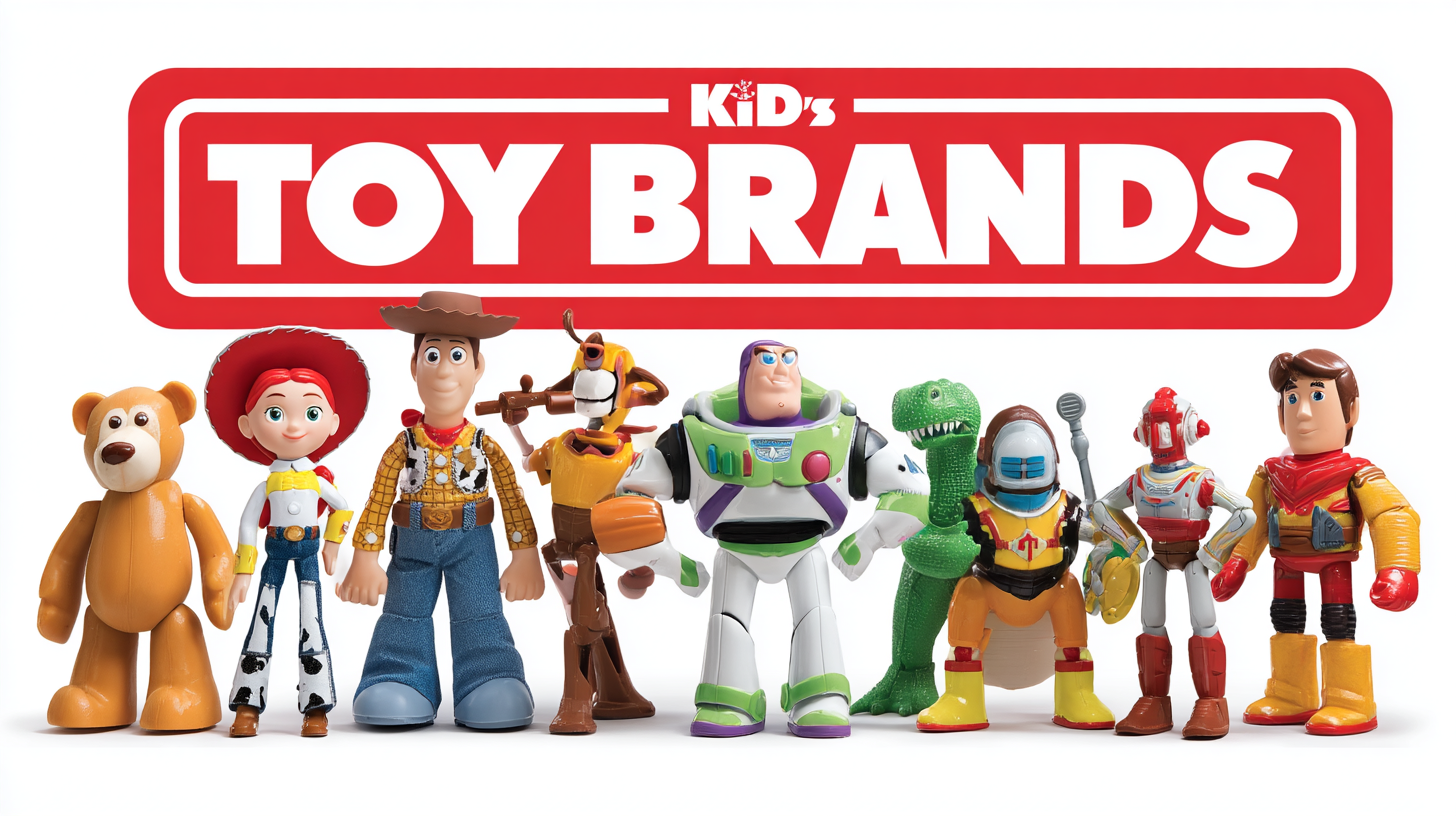As the global toy market continues to thrive, with an estimated value of over $100 billion in 2022, the importance of choosing the right kids toy brands has never been more critical for buyers. This extensive growth is driven by increasing consumer demand for innovative, educational, and safe toys that cater to children's developmental needs. Reports indicate that approximately 70% of parents prioritize educational value when selecting toys, underscoring the necessity for manufacturers to adapt and innovate continuously. In this detailed comparison guide, we aim to empower global buyers with essential insights and data, enabling them to navigate the diverse landscape of kids toy brands effectively, ensuring they make informed decisions that benefit both their businesses and the young consumers they serve.

When selecting top kids toy manufacturers, global buyers should prioritize several key factors that ensure product safety, quality, and innovation. According to the Toy Industry Association, the global toy market is projected to exceed $120 billion by 2023, underlining the competitive landscape manufacturers face. Safety compliance remains paramount; manufacturers should adhere to standards such as ASTM F963 in the U.S. and EN71 in Europe. These certifications not only guarantee product safety but also enhance consumer trust, which is increasingly vital in a market where 86% of parents prioritize safety over other features when purchasing toys.

Another critical factor to consider is the manufacturer’s commitment to sustainability and ethical practices. With a growing awareness around environmental impact, reports from the International Council of Toy Industries indicate that nearly 70% of consumers prefer brands that demonstrate eco-conscious initiatives. This trend compels manufacturers to adopt greener production processes and materials. Furthermore, examining a company's innovation track record can reveal its responsiveness to market trends; research indicates that toys equipped with STEM (Science, Technology, Engineering, and Mathematics) components have gained a 30% increase in sales over traditional toys in recent years. Therefore, buyers must meticulously evaluate these aspects to identify manufacturers that not only deliver quality toys but also align with broader consumer values.
The kids' toy industry is projected to witness substantial growth by 2025, driven by a combination of innovative product offerings and evolving consumer preferences. According to a recent report by Market Research Future, the global toy market is expected to reach USD 120 billion by the end of the forecast period, with a compound annual growth rate (CAGR) of approximately 4.5%. This growth can be attributed to factors such as increasing disposable incomes, a booming e-commerce sector, and a continuous desire for interactive and educational toys among parents.
Tip: When selecting toys, consider the market trends that focus on sustainability and educational value. Manufacturers that emphasize eco-friendly materials and designs will likely see a competitive edge as parents prioritize safety and environmental impact in their purchasing decisions.
Moreover, the rise of technology integration in toys—such as augmented reality and smart features—has been reshaping the landscape. Research by Grand View Research indicates that the electronic toys segment alone is expected to grow at a CAGR of over 10% from 2022 to 2025. As playful learning becomes a focal point, brands innovating with STEM (Science, Technology, Engineering, and Mathematics) toys are set to capture a larger market share.
Tip: Engage with suppliers who are proactive in incorporating technology into their products. This not only enhances the play experience but also aligns with educational trends that parents are increasingly catering to in 2023 and beyond.
When it comes to selecting the best kids' toy brands, a comparative analysis of leading manufacturers can provide valuable insights for global buyers. Understanding the strengths and weaknesses of different brands helps in making informed decisions that align with both budget and quality expectations. For instance, brands like LEGO and Hasbro are renowned for their creative and educational toys, while others, such as Mattel, focus on iconic characters that appeal to younger audiences.
When evaluating toy brands, consider the variety of offerings available in each product line. A diverse range of toys encourages imaginative play and caters to varying developmental stages. Look for manufacturers that prioritize safety standards and sustainability, as these factors can significantly enhance the play experience while ensuring child safety.
**Tips:** Always check for age-appropriate labels on toys, as this helps you select items that are safe and beneficial for your child’s developmental needs. Additionally, reading customer reviews can give you a real-world perspective on the durability and engagement of the toys. Lastly, keep an eye out for brands that offer educational value, as toys that promote learning can have a lasting impact on children's growth and development.
| Category | Product Types | Age Range | Safety Standards | Environmental Compliance | Market Availability |
|---|---|---|---|---|---|
| Action Figures | Superheroes, Dinosaurs, Fantasy Characters | 3-14 Years | ASTM, EN71 | ISO 14001 | North America, Europe, Asia |
| Building Sets | Blocks, Robotics | 4-12 Years | CPSC, EN71 | FSC Certified | Worldwide |
| Educational Toys | Puzzles, Science Kits | 2-10 Years | ASTM, CE | Green Product Certification | Global |
| Outdoor Toys | Slides, Swing Sets | 3-10 Years | CPSC, ASTM | Eco-Friendly Materials | Local Markets, Online |
| Arts & Crafts | Paint Sets, Craft Kits | 4-12 Years | ASTM, AP Non-Toxic | Sustainably Sourced | Global |
The importance of sustainability and safety standards in kids toy manufacturing has never been more pronounced, especially as global awareness of ethical practices in production rises. With the projected growth of the eco-friendly toys market expected to continue expanding at a steady pace, manufacturers are now under increasing pressure to produce toys that are not only engaging for children but also safe for the environment. Reports indicate that by 2034, the eco-friendly toys market is set to grow significantly due to rising consumer demand for sustainable options. The industry, currently valued at approximately $90 billion, is increasingly shifting focus towards innovative materials that minimize environmental impact.
Simultaneously, safety regulations play a crucial role in maintaining the integrity of children's products. For instance, the EU toy safety regulations are among the strictest globally, designed to protect children while ensuring seamless trade across member countries. Recent studies reveal alarming findings regarding the presence of harmful chemicals in toy products, prompting advocacy for stricter enforcement and guidelines. The ongoing concern about the safety of toys, including the alarming frequency of children using potentially toxic toy cosmetics, highlights the urgency for manufacturers to align with safety standards in every aspect of production.
As buyers globally seek out manufacturers committed to these principles, the toy industry stands at a critical junction where sustainability and safety must guide innovation and growth.
When selecting a toy manufacturer, global buyers often overlook the value of learning from successful case studies. One notable example is the collaboration between an innovative toy startup and a well-established manufacturer specializing in eco-friendly materials. This partnership not only streamlined production processes but also enhanced the brand's image as a sustainable alternative in the toy market. By integrating sustainable practices, the startup managed to appeal to environmentally conscious consumers, resulting in a 40% increase in sales within the first six months of their product launch.

Another compelling case is that of a renowned toy brand that focused on cultural sensitivity in its product designs. By partnering with manufacturers who understood the nuances of various cultures, the brand developed a line of toys that celebrated diversity. This collaboration not only led to critical acclaim but also opened up new international markets. Their ability to resonate with children from different backgrounds fostered a strong emotional connection, significantly boosting their market presence. Such case studies exemplify the importance of strategic collaborations in the toy manufacturing industry, illustrating how leveraging expertise can lead to mutual success for both buyers and manufacturers.
